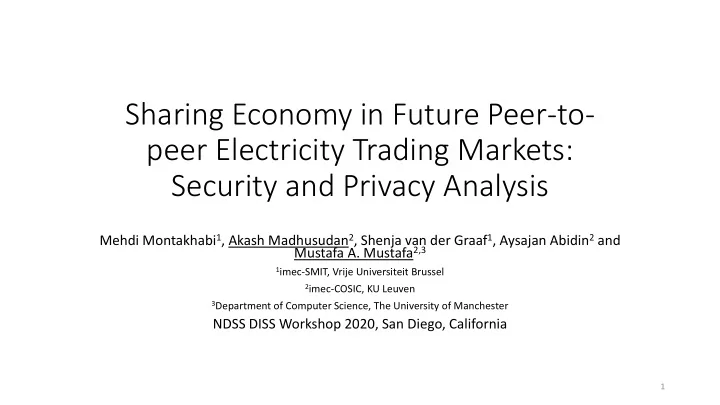

Sharing Economy in Future Peer-to- peer Electricity Trading Markets: Security and Privacy Analysis Mehdi Montakhabi 1 , Akash Madhusudan 2 , Shenja van der Graaf 1 , Aysajan Abidin 2 and Mustafa A. Mustafa 2,3 1 imec-SMIT, Vrije Universiteit Brussel 2 imec-COSIC, KU Leuven 3 Department of Computer Science, The University of Manchester NDSS DISS Workshop 2020, San Diego, California 1
Outline • Current electricity markets • P2P electricity trading market • Trading scenarios • Security & privacy analysis • Conclusions 2
Current electricity markets 3
The situation now • Users (households and SMEs) • are obliged to buy electricity from their suppliers • are not allowed to trade electricity among themselves • receive small (or no) payments for electricity fed to the grid • no payments in Flanders (Belgium) • some payments – e.g., in the UK • the export tariff is 0.047 £ /kWh (in 2017) • the average import (i.e., retail) price is 0.139 £ /kWh (in 2017) • Suppliers are the only players that can sell electricity to users 4
P2P electricity trading market 5
P2P electricity trading market 6
P2P electricity trading market 7
P2P electricity trading market 8
P2P electricity trading market 9
P2P electricity trading market 10
Scenario building The scenario analysis is aimed to answer the following questions. • What would the electricity market look like in the future in the case of p2p electricity trading? • How the existing roles change, disrupt, or disappear? • Which new roles and actors emerge in the electricity market? • What opportunities for sharing economy exist in the future electricity market? 12-3-2020 | 11
Business model matrix To identify the most important uncertainties about value creation and control issues in the future electricity market, business model matrix is used. Two main categories, value and control parameters, build the business model matrix. 12-3-2020 | 12 Table adopted from Ballon, P. (2007). Business modelling revisited: the configuration of control and value. info , 9 (5), 6-19.
Emerging roles • Prosumers: The role of a prosumer is a concoction of a local electricity producer and consumer. • Broker: This is an intermediate actor that facilitates (i.e., supports prosumers to perform) trading in the p2p electricity market. The role of a broker can be played by the grid operators. • Representatives: They manage their clients’ assets (i.e., battery, solar panels, flexibility) and information as well as represent them in electricity markets (including the p2pmarket). 12-3-2020 | 13
Scenarios S1 Direct peers: Active citizens and direct customer ownership, involving only prosumers . S2 Direct customers: Passive citizens with direct customer ownership, involving prosumers and representatives . S3 Indirect customers: Passive citizens with intermediated customer ownership, involving prosumers , representatives , and a broker . S4 Indirect peers: Active citizens with intermediated customer ownership, involving prosumers and a broker . 12-3-2020 | 14
Scenario 1 SM Smart Meter SM SM Prosumer Prosumer 1. Citizens actively participate 2. Active prosumers directly contact SM SM Prosumer Prosumer and trade electricity with each other 15
Scenario 2 R Representative SM Smart Meter SM SM Prosumer Prosumer R R SM 1. Citizens are not actively involved SM Prosumer Prosumer in trading with each other despite having the possibility to do so. R 2. Representatives trade on the p2p SM SM Prosumer Prosumer electricity market on their behalf 16
Scenario 3 R Representative SM Smart Meter SM SM Prosumer Prosumer Broker 1. Citizens are not actively R R involved in trading Broker SM SM Prosumer Prosumer 2. Broker is in contact with the representatives of prosumers 17
Scenario 4 SM Smart Meter SM SM Prosumer Prosumer 1. Citizens are actively involved Broker in trading their electricity via an intermediary SM SM Prosumer Prosumer 2. Broker is in contact with consumers and prosumers 18
Security and privacy analysis: all scenarios • Impersonation -> Authentication • Data manipulation -> MACs, Digital Signatures • Eavesdropping -> Encryption, e.g., AES • Disputes -> Digital Signatures 19
Security and privacy analysis: all scenarios • Who, when and how much electricity is selling or buying 20
Security and privacy analysis: Scenario 1 • Sybil and DoS attacks -> Authentication, secure congestion policing feedback [LYX10, ACM SIGCOMM] • Disputes, double spending -> consensus protocol to agree on a final state (PoW, PoS, etc.) • Note: PoW might be too inefficient for p2p electricity trading applications 21
Security and privacy analysis: Scenario 3 • Broker is a single point of failure -> Requirement of distributed storage (IPFS, etc. ) • DoS attacks -> secure congestion policing feedback • Inference attacks by Broker -> aggregated inputs by representatives, homomorphic encryption, multiparty computation 22
Conclusion • Applied business model matrix to identify the most important uncertainties in future p2p electricity markets • Used user involvement and data ownership to define four scenarios • Performed threat analysis on each of the defined scenarios • Specified security and privacy requirements 23
Thank you! Questions? Business model matrix for Definition of scenarios based on uncertainity prediction of p2p user involvment and data trading ownership Specification of security and Threat analysis of each Scenario privacy requirements 24
Recommend
More recommend